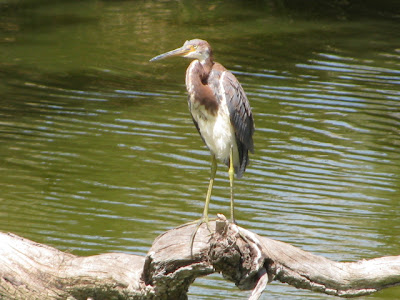New Little Blue Heron Photos
I went back to the old Kings Grant golf course and came across what I'm pretty sure is the same juvenile Little Blue I photographed there several weeks ago. You can see how its color is changing, from all white (see below photos) to, eventually, all dark blue. I plan to go back in coming weeks in hopes to see this heron again as its maturing process continues.
I shot the above photo in my cameras Vivid setting. Almost looks like a watercolor!
Previous Posting
I was planning to next feature, as part of my recent heron spree, the Great Blue. But last weekend I had a really neat encounter with a couple Little Blue Herons, so I decided to share these pictures first.
The Little Blue Heron is yet another of the Heron species that can be scene regularly in South Carolina's Lowcountry. I took these photos at what used to be a golf course near my home. This site has yet to be redeveloped and is returning to nature in many ways-- not a bad thing at all! I went back to the old Kings Grant golf course and came across what I'm pretty sure is the same juvenile Little Blue I photographed there several weeks ago. You can see how its color is changing, from all white (see below photos) to, eventually, all dark blue. I plan to go back in coming weeks in hopes to see this heron again as its maturing process continues.
I shot the above photo in my cameras Vivid setting. Almost looks like a watercolor!
Previous Posting
I was planning to next feature, as part of my recent heron spree, the Great Blue. But last weekend I had a really neat encounter with a couple Little Blue Herons, so I decided to share these pictures first.

The Little Blue is much darker than other Herons. Its purplish neck is also distinctive as is its black-tipped bill. Its also smaller than many of the other Herons.
The big surprise for me at the old golf course was enountering an immature Little Blue which is more than a little white. 
When getting these shots, I wasn't sure what kind of bird I was seeing here. Looked little a Snowy Egret some but when it moved I wasn't seeing the Snowy's bright yellow "slippers." Later at home I looked at my pictures and a few of my bird books. It was then I noticed the same black-tipped bill as the adult Little Blue.

So this outing proved a first for me in that I had never seen a juvenile Little Blue Heron before.
The Little Blue Heron is the only heron species in which first-year birds and adults show dramatically different coloration: first-year birds are pure white, while adults are blue. (source Cornell University's All About Birds website).
And quite a transformation it is!




















